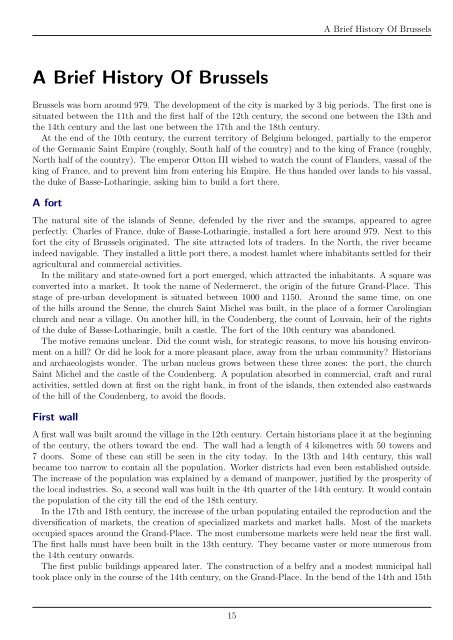booklet - ER 2011
booklet - ER 2011
booklet - ER 2011
You also want an ePaper? Increase the reach of your titles
YUMPU automatically turns print PDFs into web optimized ePapers that Google loves.
A Brief History Of Brussels<br />
A Brief History Of Brussels<br />
Brussels was born around 979. The development of the city is marked by 3 big periods. The first one is<br />
situated between the 11th and the first half of the 12th century, the second one between the 13th and<br />
the 14th century and the last one between the 17th and the 18th century.<br />
At the end of the 10th century, the current territory of Belgium belonged, partially to the emperor<br />
of the Germanic Saint Empire (roughly, South half of the country) and to the king of France (roughly,<br />
North half of the country). The emperor Otton III wished to watch the count of Flanders, vassal of the<br />
king of France, and to prevent him from entering his Empire. He thus handed over lands to his vassal,<br />
the duke of Basse-Lotharingie, asking him to build a fort there.<br />
A fort<br />
The natural site of the islands of Senne, defended by the river and the swamps, appeared to agree<br />
perfectly. Charles of France, duke of Basse-Lotharingie, installed a fort here around 979. Next to this<br />
fort the city of Brussels originated. The site attracted lots of traders. In the North, the river became<br />
indeed navigable. They installed a little port there, a modest hamlet where inhabitants settled for their<br />
agricultural and commercial activities.<br />
In the military and state-owned fort a port emerged, which attracted the inhabitants. A square was<br />
converted into a market. It took the name of Nedermerct, the origin of the future Grand-Place. This<br />
stage of pre-urban development is situated between 1000 and 1150. Around the same time, on one<br />
of the hills around the Senne, the church Saint Michel was built, in the place of a former Carolingian<br />
church and near a village. On another hill, in the Coudenberg, the count of Louvain, heir of the rights<br />
of the duke of Basse-Lotharingie, built a castle. The fort of the 10th century was abandoned.<br />
The motive remains unclear. Did the count wish, for strategic reasons, to move his housing environment<br />
on a hill? Or did he look for a more pleasant place, away from the urban community? Historians<br />
and archaeologists wonder. The urban nucleus grows between these three zones: the port, the church<br />
Saint Michel and the castle of the Coudenberg. A population absorbed in commercial, craft and rural<br />
activities, settled down at first on the right bank, in front of the islands, then extended also eastwards<br />
of the hill of the Coudenberg, to avoid the floods.<br />
First wall<br />
A first wall was built around the village in the 12th century. Certain historians place it at the beginning<br />
of the century, the others toward the end. The wall had a length of 4 kilometres with 50 towers and<br />
7 doors. Some of these can still be seen in the city today. In the 13th and 14th century, this wall<br />
became too narrow to contain all the population. Worker districts had even been established outside.<br />
The increase of the population was explained by a demand of manpower, justified by the prosperity of<br />
the local industries. So, a second wall was built in the 4th quarter of the 14th century. It would contain<br />
the population of the city till the end of the 18th century.<br />
In the 17th and 18th century, the increase of the urban populating entailed the reproduction and the<br />
diversification of markets, the creation of specialized markets and market halls. Most of the markets<br />
occupied spaces around the Grand-Place. The most cumbersome markets were held near the first wall.<br />
The first halls must have been built in the 13th century. They became vaster or more numerous from<br />
the 14th century onwards.<br />
The first public buildings appeared later. The construction of a belfry and a modest municipal hall<br />
took place only in the course of the 14th century, on the Grand-Place. In the bend of the 14th and 15th<br />
15




